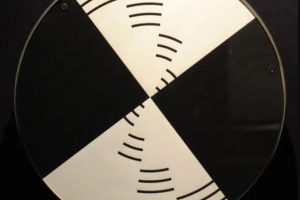Date: Friday 11 November 2022 – Saturday 19 November 2022
Experience the visual illusions and altered states of consciousness created by flickering light.
Exhibition
Free Entry. Monday – Saturday. 10am – 4pm.
Closed Sundays & Bank Holidays.
Plan your visit here.
Experience Ganzflicker, a centuries-old psychedelic flickering light practice that creates visual illusions and altered states of consciousness, and has been used to reveal the hidden inner workings of the human imagination. Open your eyes to a showcase of historic Ganzflicker techniques and discover what artists and scientists have to say about the mind’s ability to shape the experience of reality.
The exhibition from Dr Reshanne Reeder will include interactive installations and activities aimed at all ages, including video projections, wearable “hypnobuckets”, an art and collage table where you can illustrate your personal Ganzflicker experiences, and a research station where you can sign up for scientific studies.
- Gysin’s Dreamachine
- Ganzflicker
- Benham’s Top
- Hypnobuckets
Family Friendly Events
Sat 12 Nov: 10am – 4pm
Sat 19 Nov: 10am – 4pm
Family friendly events are drop in, booking is not required.
Meet the project researcher and try a few family-friendly Ganzflicker activities.
Special Events
Free. Booking is required via Eventbrite.
Fri 11 Nov: 5pm – 8pm
Sat 12 Nov: 4pm – 6pm
Join us for the opening event on Friday 11 November and an after hours event on Saturday 12 November.
Fri 18 Nov: 7pm – 9pm
Sat 19 Nov: 6pm – 8pm
Lots of people have wild and colourful visual experiences using the various Ganzflicker techniques that are showcased in the exhibition – but sometimes it’s hard to translate that experience into art! Kirsten Baron is a professional artist who has expertise painting the visual imagination. During the special events on 18 & 19 November, she will be available in The Atkinson to bring your Ganzflicker experience to the canvas!
Content Warning
Strobe lighting will be used during the event. It may be unsafe for those with epilepsy and other conditions with sensitivity to light. Seating will be available to view demonstrations and video projections, and the two flickering demos will occur behind blackout curtains. Those with photosensitive epilepsy are advised not to view the flickering demonstrations.
Visual Illusions
Ganzflicker
..
Ganzflicker is an intense full-screen, red-and-black flicker that anyone can access online and that Dr Reeder uses in her experiments. In less than 10 minutes, it creates altered states of consciousness, with no lasting effects for the brain. Visual experiences set in almost as soon as you start looking at it.
Hypnobuckets
- Hypnobuckets
From the mind of an engineer – and showcased at dance clubs, music and art festivals, space camps, and tech events – come the exceedingly popular and curious hypnobuckets. Put one bucket over your friend’s head, and one over your own, and experience what creator Eliot Phillips lovingly calls “Brain transference” as you control the shared psychedelic effect.
Benham’s Top
- Benham’s Top
In 1895, the English toymaker and amateur scientist Charles Benham produced a top with a monochrome pattern that, when spun, causes colours to be seen at different places on the disc. He sold it as the ‘Artificial Spectrum Top’. The perception of colours in Benham’s top is not the same for everyone. Different people see different shades in the same disc. But when its spinning direction is reversed, or when the disc accelerates or decelerates, a change in colours is perceived universally.
Dreamachine
..
Flicker-effects entered art when, in the early 1960s, the painter and writer, Brion Gysin collaborated with the mathematician Ian Sommerville to produce what he called the Dreamachine: a cylinder with slits cut in the sides and a light bulb suspended at its centre, placed on a record turntable and rotated at 78 revolutions per minute. As the viewer faced it with their eyes closed, the flickering light caused trance-like hallucinations.
Being Human festival
This event is part of the Being Human festival, the UK’s national festival of the humanities, taking place 10–19 November 2022. Led by the School of Advanced Study, University of London, in partnership with the Arts and Humanities Research Council and the British Academy. For further information please see beinghumanfestival.org












